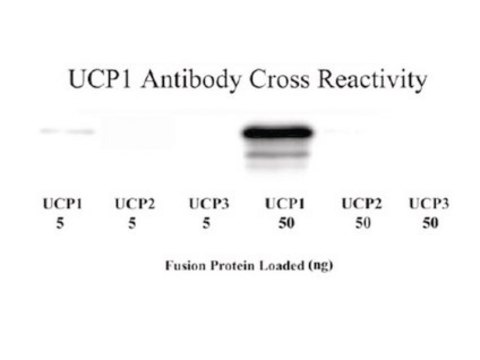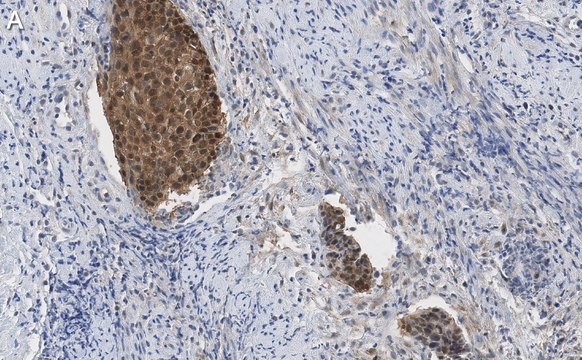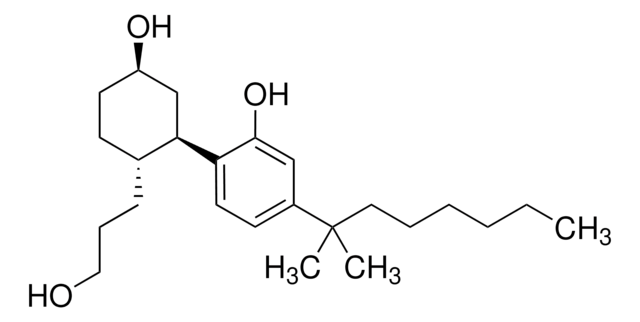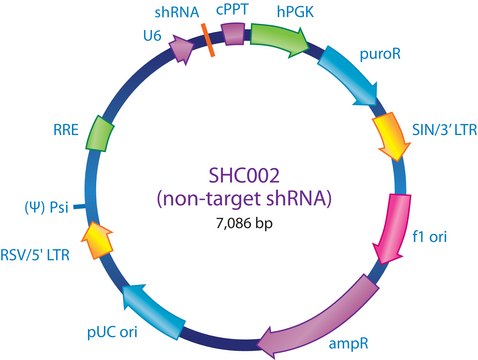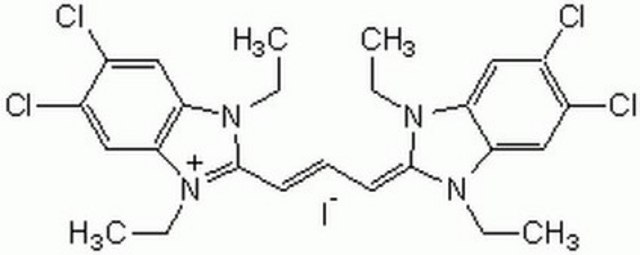AB3036
Anti-Uncoupling Protein 1 Antibody
Chemicon®, from rabbit
Synonym(s):
UCP1
Sign Into View Organizational & Contract Pricing
Select a Size
All Photos(1)
Select a Size
Change View
About This Item
UNSPSC Code:
12352203
eCl@ss:
32160702
NACRES:
NA.41
Recommended Products
biological source
rabbit
Quality Level
antibody form
affinity purified immunoglobulin
antibody product type
primary antibodies
clone
polyclonal
purified by
affinity chromatography
species reactivity
mouse
manufacturer/tradename
Chemicon®
technique(s)
ELISA: suitable
western blot: suitable
NCBI accession no.
Specificity
Uncoupling Protein 1 (UCP1), mouse. Mouse/rat UCP1 is a 307 amino acid mitochondrial uncoupling protein (Bouillaud et al. 1986; Ridley et al. 1986; Kozak et al. 1988; Cassard et al. 1990; Miroux et al. 1993). It is only 59% homologous with UCP2 (Fleury et al. 1997). Human UCP1 is located on chromosome 4 (Bouillaud et al. 1986; Ridley et al. 1986; Kozak et al. 1988; Cassard et al. 1990; Miroux et al. 1993). UCP1 is primarily expressed in brown adipose tissues.
The antibody has not yet been tested for cross-reactivity to other species. The sequence used for immunization shows 100% homology to rat, 91% with golden hamster, 83% with rabbit and 75% with human and canine UCP1.
The antibody has not yet been tested for cross-reactivity to other species. The sequence used for immunization shows 100% homology to rat, 91% with golden hamster, 83% with rabbit and 75% with human and canine UCP1.
Immunogen
A 12 aa peptide at the C-terminus of the mouse/rat UCP1 (Bouillaud et al. 1986; Ridley et al. 1986; Kozak et al. 1988; Cassard et al. 1990; Miroux et al. 1993).
Application
Detect Uncoupling Protein 1 using this Anti-Uncoupling Protein 1 Antibody validated for use in ELISA & WB.
Western Blotting: 1-10 μg/mL using Chemiluminescence technique. An antibody made to this epitope has detected a protein of ~32 kDa in brown adipose tissues (Feil & Rafael 1994).
ELISA: 1:10,000-1:100,000; using 50-100 ng UCP1 control peptide/well.
Optimal working dilutions must be determined by end user.
ELISA: 1:10,000-1:100,000; using 50-100 ng UCP1 control peptide/well.
Optimal working dilutions must be determined by end user.
Physical form
Affinity purified immunoglobulin. Liquid in PBS with less than 0.1% sodium azide.
Other Notes
Concentration: Please refer to the Certificate of Analysis for the lot-specific concentration.
Legal Information
CHEMICON is a registered trademark of Merck KGaA, Darmstadt, Germany
Not finding the right product?
Try our Product Selector Tool.
Storage Class
12 - Non Combustible Liquids
wgk_germany
WGK 2
flash_point_f
Not applicable
flash_point_c
Not applicable
Certificates of Analysis (COA)
Search for Certificates of Analysis (COA) by entering the products Lot/Batch Number. Lot and Batch Numbers can be found on a product’s label following the words ‘Lot’ or ‘Batch’.
Already Own This Product?
Find documentation for the products that you have recently purchased in the Document Library.
Our team of scientists has experience in all areas of research including Life Science, Material Science, Chemical Synthesis, Chromatography, Analytical and many others.
Contact Technical Service